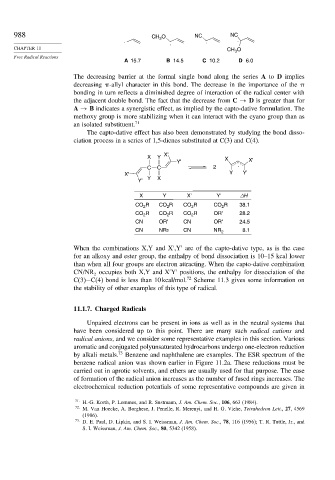Page 1004 - Advanced Organic Chemistry Part A - Structure and Mechanisms, 5th ed (2007) - Carey _ Sundberg
P. 1004
988 CH O NC NC
. 3 . .
.
CHAPTER 11 O
CH 3
Free Radical Reactions
A 15.7 B 14.5 C 10.2 D 6.0
The decreasing barrier at the formal single bond along the series A to D implies
decreasing -allyl character in this bond. The decrease in the importance of the
bonding in turn reflects a diminished degree of interaction of the radical center with
the adjacent double bond. The fact that the decrease from C → D is greater than for
A → B indicates a synergistic effect, as implied by the capto-dative formulation. The
methoxy group is more stabilizing when it can interact with the cyano group than as
an isolated substituent. 71
The capto-dative effect has also been demonstrated by studying the bond disso-
ciation process in a series of 1,5-dienes substituted at C(3) and C(4).
X'
X Y X
Y' X'
C C 2 .
X' Y Y'
Y' Y X
X Y X' Y' ΔH
CO R CO R CO R CO R 38.1
2
2
2
2
CO R CO R CO R OR' 28.2
2
2
2
CN OR' CN OR' 24.5
CN NR2 CN NR 2 8.1
When the combinations X,Y and X ,Y are of the capto-dative type, as is the case
for an alkoxy and ester group, the enthalpy of bond dissociation is 10–15 kcal lower
than when all four groups are electron attracting. When the capto-dative combination
CN/NR occupies both X,Y and X Y positions, the enthalpy for dissociation of the
2
C(3)−C(4) bond is less than 10 kcal/mol. 72 Scheme 11.3 gives some information on
the stability of other examples of this type of radical.
11.1.7. Charged Radicals
Unpaired electrons can be present in ions as well as in the neutral systems that
have been considered up to this point. There are many such radical cations and
radical anions, and we consider some representative examples in this section. Various
aromatic and conjugated polyunsaturated hydrocarbons undergo one-electron reduction
by alkali metals. 73 Benzene and naphthalene are examples. The ESR spectrum of the
benzene radical anion was shown earlier in Figure 11.2a. These reductions must be
carried out in aprotic solvents, and ethers are usually used for that purpose. The ease
of formation of the radical anion increases as the number of fused rings increases. The
electrochemical reduction potentials of some representative compounds are given in
71
H.-G. Korth, P. Lommes, and R. Sustmann, J. Am. Chem. Soc., 106, 663 (1984).
72 M. Van Hoecke, A. Borghese, J. Penelle, R. Merenyi, and H. G. Viehe, Tetrahedron Lett., 27, 4569
(1986).
73
D. E. Paul, D. Lipkin, and S. I. Weissman, J. Am. Chem. Soc., 78, 116 (1956); T. R. Tuttle, Jr., and
S. I. Weissman, J. Am. Chem. Soc., 80, 5342 (1958).

